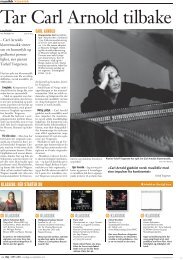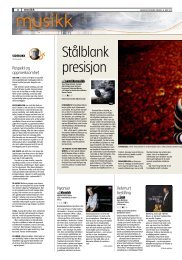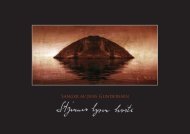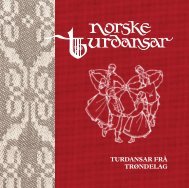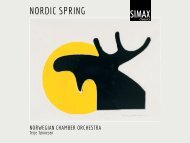J. S. BACH G. PH. TELEMANN 1B1 - Grappa Musikkforlag
J. S. BACH G. PH. TELEMANN 1B1 - Grappa Musikkforlag
J. S. BACH G. PH. TELEMANN 1B1 - Grappa Musikkforlag
Create successful ePaper yourself
Turn your PDF publications into a flip-book with our unique Google optimized e-Paper software.
een held that the work’s original form was as a<br />
concerto for oboe and violin, and a scholarly<br />
reconstruction of this version has been published<br />
in the Neue Bach-Ausgabe as BWV 1060R. This<br />
in turn has been the basis for Kuuskmann and<br />
Tomter’s presentation of the work as a concerto<br />
for bassoon and viola, which gives new form to<br />
the beauty of Bach’s music. The work recalls<br />
especially the well-known Concerto for two<br />
violins, BWV 1043 and, as in that work, the writing<br />
is not especially weighted to instrumental<br />
virtuosity; instead Bach treats the concerto<br />
principle as a conversation of equal partners,<br />
blurring the distinction between solo and tutti.<br />
Cast once again in three movements, BWV 1060<br />
opens with an Allegro that is both rhythmically<br />
alert and undeniably tuneful. The strings give out<br />
the striking principal theme, but the attractive<br />
secondary subject and related motifs are<br />
announced by the bassoon and viola: indeed the<br />
soloists rarely have the first theme to themselves<br />
but engage in deft contrapuntal explorations<br />
around it as well as bursts of colourful bravura<br />
writing. This is particularly evident in the opening<br />
ritornello of the first movement, in which the<br />
soloists echo phrases as also in the first episode<br />
of the last movement, where the tutti strings<br />
repeat exactly phrases developed by the soloists.<br />
Martin Kuuskmann has explained his approach to<br />
adapting this movement for the bassoon as<br />
follows: ‘I ended up taking out most of the solo<br />
8<br />
lines in the first and third movements that were in<br />
unison with the first violins, instead playing such<br />
parts of the concerto along with the continuo,<br />
until the solo part set off independently again,<br />
thus following the Baroque bassoon concerto<br />
format. So, instead of having both soloists play<br />
along in the very beginning as people are use to<br />
hearing this famous work, [viola and bassoon] are<br />
instead playing along with each of [their]<br />
instrument families, etc’.<br />
The central Adagio is a movement of wonderful<br />
serenity, the bassoon having the long-breathed<br />
main theme at the outset, which is then taken<br />
over by the viola. Here the strings create a<br />
subdued background against which the soloists<br />
are able to spin an elegant and affecting<br />
contrapuntal web with their cantabile writing, the<br />
vertical alignment of their parts creating the<br />
essential harmonies. It is worth relaying Martin<br />
Kuuskmann’s comments on this movement also:<br />
‘Here, both solo bassoon and solo viola parts<br />
move independently from the orchestra; and<br />
although both parts are now most obviously<br />
played an octave lower from the original, the<br />
beautiful mix of the mellow timbres between the<br />
bassoon and viola and the rest of the ensemble<br />
brings forth the most beautiful and personal parts<br />
of this concerto […] it is truly as if sung by two<br />
human voices, as both instruments are now<br />
playing in a comfortable range for the human<br />
voice. To me personally, this movement is truly<br />
some of the most ingenious and incredible writing<br />
in the whole history of music -- the melody, the<br />
intertwining solo parts and the special aura this<br />
movement creates both musically and<br />
emotionally simply doesn't get any more perfect.’<br />
After this, the finale is typically busy and<br />
energetic, presenting the soloists with a whole<br />
range of challenges to their virtuoso technique.<br />
Although Bach was an enormously prolific<br />
composer, he – and just about everyone else –<br />
was outdone in this regard by Georg Philipp<br />
Telemann, whose total of works runs into the<br />
thousands. Perhaps one of the reasons<br />
Telemann’s Viola Concerto in G Major – the only<br />
such solo concerto he is known to have written –<br />
is so popular is the elegant manner in which it<br />
effects a junction between high Baroque style<br />
and the lighter style galant that began to overtake<br />
it towards the end of Telemann’s life, as a<br />
reaction to what had come to be seen as the<br />
ponderous, academic and old-fashioned<br />
Baroque. It might seem that very little common<br />
ground could be found between the two idioms,<br />
but in this delightful concerto Telemann (who<br />
was himself a violist) achieved a fusion of styles<br />
to create effective contrasts within a sense of<br />
overall unity. Unlike Bach’s preference in his<br />
concertos for the three-movement sonata da<br />
camera form, fast-slow-fast, Telemann casts his<br />
in the slow-fast-slow-fast form of the Baroque<br />
sonata da chiesa. A wistful opening Largo with<br />
9<br />
an unexpected little cadenza introduces a much<br />
lighter, gracefully melodic Allegro in the galant<br />
manner. The melancholic Andante, like the<br />
opening movement, features a small cadenza,<br />
and the concerto concludes with an ebullient<br />
Presto. Throughout, Telemann shows himself an<br />
adept in the distinctive tones and timbre of the<br />
viola from its lowest to its highest register.<br />
Telemann’s Concerto in G Major for two violas,<br />
strings and basso continuo bears the title<br />
‘Concert par Monsieur Telemann pour 2 violettes,<br />
2 violons, taille et basse’ – the use of the term<br />
‘violette’ for the viola is also found in Vivaldi, who<br />
referred to the instrument as the ‘Violette<br />
all’inglese’, though why it was regarded as a<br />
particularly English instrument is unknown.<br />
Tomter and Kuuskmann here offer a version for<br />
viola and bassoon of this diverting little concerto.<br />
This again is in four-movement form, though in<br />
this case the opening movement, designated<br />
Avec douceur, is more like a formal overture,<br />
with the soloists often subsumed into the<br />
orchestral ensemble. The second movement,<br />
marked Gay, is an exuberant dance in which the<br />
soloists come more to the fore, alternating with<br />
robust ensemble writing. The Largo third<br />
movement is solemnly expressive and<br />
emotionally poised, acting as a slow introduction<br />
to the finale, Vivement, which is again a jocund<br />
dance-movement requiring considerable bravura<br />
from the soloists.




